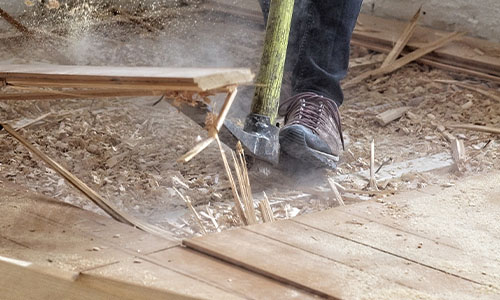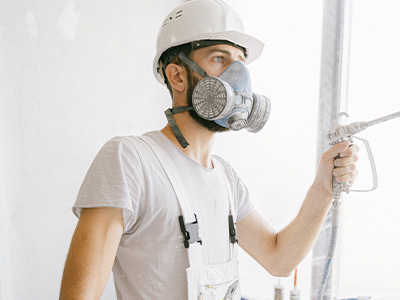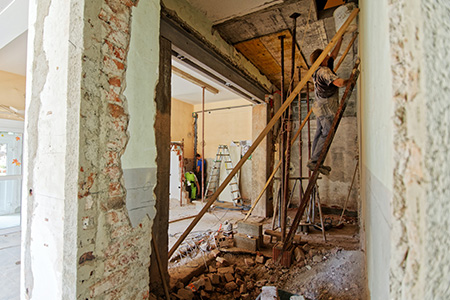Diving into a DIY home renovation is an adventure filled with possibilities, but it’s also important to navigate this journey safely. A hidden concern in many older homes is asbestos—a material once commonly used, and now known to pose serious health risks. Understanding asbestos safety risks, where asbestos might be found, how to identify it, and the proper steps for mitigating risk are key to safety. This article will arm you with practical, useful knowledge, from detection to risk mitigation, to ensure your home makeover is not only beautiful but is also safe.
It is CRITICAL TO NOTE that untrained personnel should NOT attempt to abate or remove asbestos; this guide is for working around undamaged asbestos, not with it directly. If you suspect that your home or office contains asbestos, please contact a professional for identification, testing, and abatement. Pristine Restoration assumes NO LIABILITY for untrained persons attempting to work with, abate, or remove asbestos from a home or office!
Identifying Asbestos
First, let’s demystify asbestos: understanding what it is, its place in history, and the right and wrong ways to identify it are key steps before starting any home renovation.
Asbestos is a group of natural minerals that are made up of fine, durable fibers resistant to heat, fire, and many chemicals. This makes asbestos traditionally valued in construction for insulation and as a fire retardant.
Historically, asbestos was once a celebrated material in building and manufacturing, extensively used from the late 1800s for its remarkable properties like heat resistance and strength. It was commonly found in products like insulation, roofing shingles, and even textiles. But over time, we’ve learned of its dangerous side. Prolonged inhalation of asbestos fibers can cause severe health issues. Today, we handle asbestos with great care to protect our health and well-being, mindful of its legacy in our buildings.
The presence of asbestos is not able to be confirmed visually. It’s not detectable by color or texture, and there’s no telltale sign to alert you to its presence in materials like insulation, tiles, or siding. Smelling or touching it won’t reveal asbestos either. In fact, trying to identify it in this way could release harmful fibers into the air. Asbestos is hidden integral to various building materials, making it a challenge to detect without professional help.
To properly identify asbestos, a certified professional will take samples from your home or office and analyze them in a lab. Specialized microscopes are used to identify the unique fibers that characterize asbestos. This scientific method is the only reliable way to confirm its presence. If you suspect that materials in your home contain asbestos, especially before a renovation, always call an expert for testing to ensure everyone’s safety.

Asbestos Safety Risks
Asbestos is a carcinogen, which means it’s known to cause lung cancers, and in particular, mesothelioma. Mesothelioma is a cancer that affects the lining of the lungs and is closely linked to asbestos exposure. It’s aggressive and often undetected until it’s advanced, making awareness and early detection critical.
Asbestosis is another medical condition that can be caused by asbestos exposure. Unlike cancer, asbestosis is a chronic lung condition resulting from prolonged exposure to high levels of asbestos fibers. It scars lung tissue, causing shortness of breath and persistent coughing. Asbestosis can severely impact quality of life and is a stark reminder of asbestos risk.
The amount of asbestos exposure considered dangerous to humans and animals is not straightforward; it can vary greatly. Even small amounts can be harmful over time, especially for those with prolonged exposure. Occupations with historical asbestos contact show that no “safe” level exists, and even brief exposures can have long-term consequences. It’s a cumulative hazard—the more you’re exposed, the greater the risk for developing asbestos-related diseases. Thus, prevention through proper handling and professional assistance is essential.

Safety Precautions
While we share asbestos safety guidance to help you mitigate risks, please understand that this information is not a substitute for professional advice. If you suspect the presence of asbestos in your home, it’s imperative to halt all work and consult a professional, especially if the asbestos is damaged or loosely bound.
Where Is Asbestos Likely to be Found?
When planning home improvements, it’s vital to consider the era in which your home was built. Houses constructed before the 1980s are more likely to contain asbestos in various building materials. Checking your home’s construction date is a crucial step in identifying potential asbestos safety risks, which can inform safer renovation practices or indicate the need for a professional asbestos inspection. Stay informed and prioritize health and safety in every step of your home renovation journey.
Asbestos might be hidden in less obvious places throughout your home, beyond the well-known spots like insulation or floor tiles. Careful attention is needed to identify these areas, particularly if alterations or repairs are in your plans. Here is a good list of the places asbestos could be present:
- Popcorn ceilings and textured paints
- Insulation in walls, attics, and around pipes
- Vinyl floor tiles and sheet flooring backing
- Roofing shingles and siding
- Window caulking and glazing
- Wall and ceiling joint compounds
- Ductwork and heating system insulation
- Boiler and furnace insulations
- Door gaskets in furnaces and wood stoves
- Electrical switchboard panels
- Certain acoustic tiles
- Decorative plaster
- Chimneys
- Fireproofing materials on steelwork
- Old decorative items that may contain asbestos fibers
- Linings of old heaters and stoves
- Thermal paper products

Avoid Disturbance of Asbestos
If your home contains undamaged asbestos materials, it’s crucial to leave them undisturbed. These materials, when intact, are less likely to release asbestos fibers, which can be harmful when inhaled. Before making changes to your home, if you suspect materials contain asbestos, consult a professional. Disturbing these materials without proper safety measures can increase the risk of exposure, potentially affecting the health of you and your loved ones.

When working around materials that may contain asbestos, never use tools that create dust, such as power saws, sanders, or drills. These can release asbestos fibers into the air. Also, avoid high-pressure hoses or abrasive pads, which can similarly disturb asbestos and create a hazardous environment. Always prioritize safety and if in doubt, stop the work and seek advice from an asbestos abatement professional to manage these materials properly.
Protective Gear
When dealing with potential asbestos exposure during home projects, wearing a properly fitting mask is key. Choose a respirator certified for asbestos filtration to ensure it effectively traps harmful fibers. A snug fit is essential to prevent airborne particles from being inhaled. Remember, regular dust masks aren’t enough; safety comes first, so invest in the right protection for your health.
Additionally, it’s smart to wear disposable clothing while working around asbestos. Overalls or coveralls that can be discarded after the job prevent fibers from clinging to your everyday attire. After work, carefully remove and dispose of these clothes following safety guidelines to avoid contaminating your home or putting others at risk. Safety extends beyond the work; it’s about keeping safe long after the tools are down.

Professional Asbestos Abatement
Professional asbestos removal or sealing—also known as abatement—ensures that any asbestos-containing materials are safely and effectively handled. Trained experts use specialized equipment and techniques to either remove the asbestos or seal it in place, preventing fibers from becoming airborne. This process is crucial for maintaining a safe environment in your home or building.
Professional asbestos abatement is recommended when the materials are damaged, disturbed during renovations, or could become a hazard due to deterioration. An asbestos professional can assess the condition and advise whether removal or sealing is the best course of action, ensuring the safety of everyone in the building.
Renovating your home can be rewarding, transforming it into a space that’s both functional and reflective of your style. However, the safety of your home extends beyond aesthetics, especially when it comes to asbestos. We’ve discussed how to spot it, handle it, and when to call professionals. Remember, when dealing with asbestos, it’s not just about what you can see or touch; it’s about ensuring the health and longevity of your home and those within it. Stay informed, stay safe, and when in doubt, always rely on the expertise of professionals.


